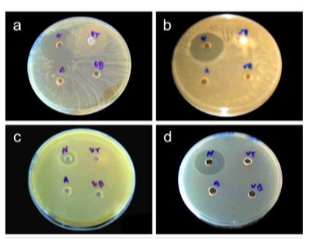Nisin in the biopreservation of Bordô (Ives) and Niágara table wines from Santa Catarina, Brazil
DOI:
https://doi.org/10.20873/jbb.uft.cemaf.v4n3.nerisKeywords:
antimicrobial, lactic acid bacteria, malolactic fermentation, vinification, bacteriocinAbstract
The searches for new antimicrobial compounds to control the lactic acid bacteria in winemaking are based in the increasing global concern about the chemical preservatives restrictions and the development of super-resistant strains continuously exposed to sulfites in wineries for decades. The antimicrobial activity of the nisin as a biopreservative was studied for Bordô (Ives) and Niágara grape wines from Santa Catarina, Brazil. Measurements of antimicrobial activity were made by well-diffusion assays. From the eleven previously assessed strains of nisinsusceptible lactic bacteria (nisin concentration 1000 IU ml-1), four were selected for definitive assays with nisin (100 IU ml-1) dissolved in the wines. Positive results for inhibition were obtained for the four strains selected. Next, the direct inhibitory action was assessed in wines artificially inoculated and then treated with nisin. After 60 days of storage, there was reduction in the total bacterial population as compared to control, especially in Bordô (Ives) wine, while the physic-chemical parameters were not influenced by the nisin treatment. The inhibitory activity of nisin was not affected when it was dissolved in wine in the antimicrobial assays, and its potential utilization as biopreservative should be able to aid on the control of autochthonous microbiota, but further studies are required to conclude more precisely the nisin effects at long term in wines.
References
AMMOR S., TAUVERON G., DUFOUR E., Procedures, 2 ed. Springer, New York, 408p.
CHEVALLIER I. Antibacterial activity of lactic acid bacteria against spoilage and pathogenic bacteria isolated from the same meat small-scale facility 1— screening and characterization of the antibacterial compounds. Food Control, v. 17, p. 454–461, 2006.
ARAUZ LJ., JOZALA AF., MAZZOLA PG., PENNA TCV. Nisin biotechnological production and application: a review. Trends in Food Science & Technology, v. 20, p. 146-154, 2009.
BRASIL, 2006. Metodologia de análise de vinhos. 21 ed. Bento Gonçalves, RS, 157 p.
COSTANTINI A., GARCÍA-MORUNO E., MORENO-ARRIBAS MV., 2009. Biochemical Transformations Produced by Malolactic Fermentation – chapter 2. In: Wine Chemistry and Biochemistry. Springer, New York, 728p.
DAESCHEL, MA., JUNG, D-S., WATSON BT. Controlling wine malolactic fermentation with nisin and nisin-resistant strains of Leuconostoc oenos. Applied and Environmental Microbiology, v. 57, n. 2, p. 601-603, 1991.
DAESCHEL MA., BOWER C., 1993-1994. The use of nisin resistant strains of Leuconostoc oenos to control malolactic fermentation and to prevent the growth of spoilage bacteria in Oregon wines. Research Progress Report, Oregon State University, Corvallis, USA.
DU PLESSIS HW., DICKS LMT., PRETORIUS IS., LAMBRECHTS MG., DU TOIT M. Identification of lactic acid bacteria isolated from South African brandy base wines. International J. of Food Microbiology, v. 91, p. 19-29, 2004.
GUZZO J., JOBIN M-P., DIVIÈS C. Increase of sulfite tolerance in Oenococcus oeni by means of acidic adaptation. FEMS Microbiology Letters, v. 160, p.43-47, 1998.
KNOLL C., DIVOL B., DU TOIT M. Influence of Phenolic Compounds on Activity of Nisin and Pediocin PA-1. American Journal of Enology and Viticulture, v. 59, n. 4, p. 418-421, 2008.
LAFON-LAFOURCADE S., CARRE E., RIBEREAU-GAYON P. Occurrence of Lactic Acid Bacteria During the Different Stages of Vinification and Conservation of Wines. Applied and Environmental Microbiology, v. 46, n 4, p. 874-880, 1983.
OLIVA-NETO P., YOKOYA F. Susceptibility of Saccharomyces cerevisiae and lactic acid bacteria from the alcohol industry to several antimicrobial compounds. Brazilian Journal of Microbiology, v. 32, p. 10-14, 2001.
RADLER F. Possible Use of Nisin in Winemaking I - Action of Nisin Against Lactic Acid Bacteria and Wine Yeasts in Solid and Liquid Media. American Journal of Enology and Viticulture, v. 41, n. 1, p. 1-6, 1990a.
RADLER F. Possible Use of Nisin in Winemaking II - Experiments to Control Lactic Acid Bacteria in the Production of Wine. American Journal of Enology and Viticulture, v. 41, n. 1, p. 7-11, 1990b.
ROJO-BEZARES B., SÁENZ Y., ZARAZAGA M., TORRES C., RUIZ-LARREA F. Antimicrobial activity of Nisin Against Oenococcus oeni and Other Wine Bacteria. International Journal of Food Microbiology, v. 116, p. 32-36, 2007.
STRATIOTIS A.L., DICKS L.M.T. Identification of Lactobacillus spp. isolated from different phases during the production of a South African Fortified Wine. South African Journal of Enology and Viticulture, v. 23, n. 1, p. 14-21, 2002.
ZACHARAF MP., LOVITT RW. Bacteriocins Produced by Lactic Acid Bacteria: A Review Article. APCBEE Procedia, v. 2, p. 50-56, 2012.

Published
How to Cite
Issue
Section
License
Copyright (c) 2024 - Journal of Biotechnology and Biodiversity

This work is licensed under a Creative Commons Attribution 4.0 International License.
Authors who publish with this journal agree to the following terms:
Authors retain copyright and grant the journal right of first publication with the work simultaneously licensed under a Creative Commons Attribution License (CC BY 4.0 at http://creativecommons.org/licenses/by/4.0/) that allows others to share the work with an acknowledgement of the work's authorship and initial publication in this journal.
Authors are able to enter into separate, additional contractual arrangements for the non-exclusive distribution of the journal's published version of the work (e.g., post it to an institutional repository or publish it in a book), with an acknowledgement of its initial publication in this journal.
Authors are permitted and encouraged to post their work online (e.g. in institutional repositories or on their website) prior to and during the submission process, as it can lead to productive exchanges, as well as earlier and greater citation of published work (Available at The Effect of Open Access, at http://opcit.eprints.org/oacitation-biblio.html).


